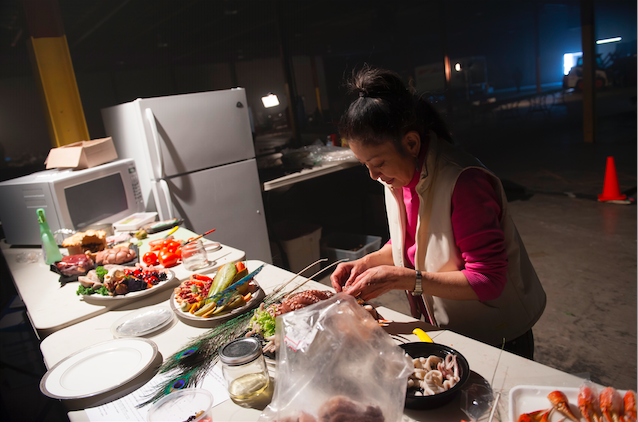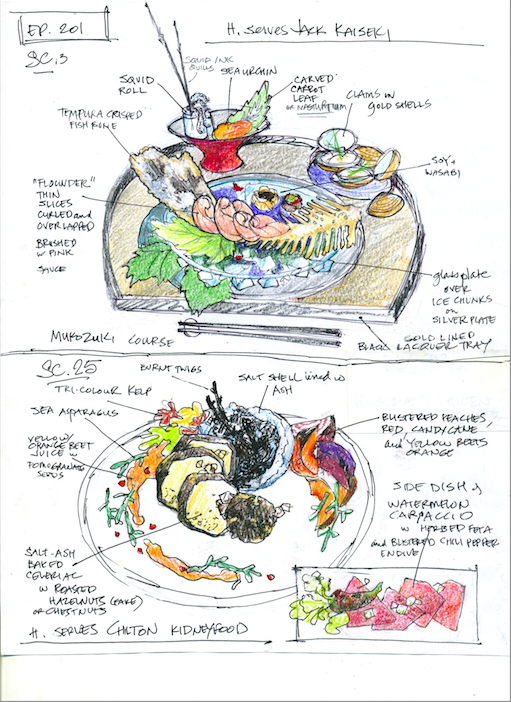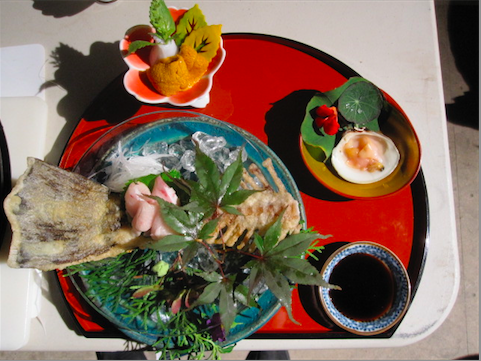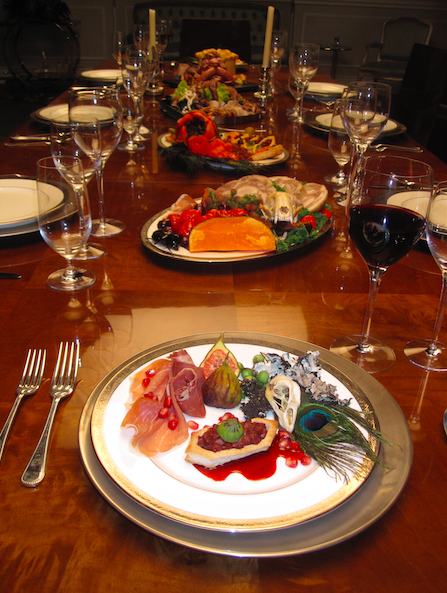
Food stylist Janice Poon at the scene of the crime. Photo courtesy of Brooke Palmer and NBC/Sony.
NBC’s Hannibal is gruesome, savage and eerily beautiful. Executive producer-writer Bryan Fuller and an impressive ensemble cast is responsible for much of this, but less obvious but nevertheless crucial are the immaculate on-screen meals the titular cannibal feeds his guests. The woman behind Hannibal‘s menu is Toronto native Janice Poon, an artist, writer, and food stylist who documents her hand in Dr. Lecter’s culinary crimes against humanity on her blog, Feeding Hannibal. In anticipation of the show’s second season premiere, Deadshirt staffer Max Robinson interviewed Miss Poon over the phone and discussed her career, her day to day and the surprisingly philosophical nature of her contributions to Hannibal.
MR: So I guess the obvious but necessary way to get this interview started is by asking how you found yourself involved in food styling? Was that a natural extension of your career as an artist?
JP: No, it was a totally unnatural extension of my art career and totally unexpected! I was going to be like an advertising genius and, you know, change the world of advertising which as we know is patronizing and sexist and misogynistic and all those things. So I went to commercial art school and got a job as an art director at a huge, powerful agency and started to discover it’d take more than me to change advertising [laughs]. So while I was being wrestled to the ground by the code of advertising I had three food accounts: McDonalds, Kraft and Maple Leaf. So it was during a McDonald’s shoot that I first encountered food styling, because it may surprise you to know that it isn’t on the list of things you can be right after college.
MR: It’s not one that immediately springs to mind when you’re heading out of higher education [laughs].
JP: Exactly! But I was watching this food stylist, I guess they called it a “home economist” then since they didn’t think it’s an art, they thought it was a question of counting or something. “Three chips on that plate and one bun and two patties on that plate and you’re done”. Anyway I’m busy being art director, which means folding your arms and being useless, and I’m watching the guys from McDonalds getting the Big Mac ready for its big camera moment. And it wasn’t like a big light went on so much as I went “Holy cow, this is…interesting.” They backed up a giant truck behind the studio and unloaded boxes and cartons and containers of frozen chips, burgers, racks of freshly baked sesame buns. We spent the first three hours just opening these bags and looking for perfect french fries, perfect buns and cooking them up and hoping they warp the right way so they look fluffy and voluminous. When I saw the guy skewering the long beautiful beautiful french fries so they’d stand up perfectly straight in the box. You know that little red box.
MR: I’m familiar.
JP: I watched him working those skewers and I thought “It’s so duplicitous, it’s so….I don’t want to say it’s a lie but it’s so wrong and yet it’s so right for me!”. I mean, I can take a fact and turn it into a fiction; this is right up my alley. I didn’t quit my day job though, I just observed through my food accounts and thought “Hm well I think I’d do it this way or I’d do it that way” and then something would happen where a food stylist wouldn’t show up on time and I’d step in. Just slowly insinuating myself, not really on purpose or anything, it just happened.
MR: Basically an accidental, self-taught apprenticeship.
JP: Yeah! Yeah, kind of. I mean we’re all just trying to get the shot so we can go out for drinks. As I became a more experienced art director on commercials, that gave me a taste for how things are done on film. And that just slowly fed into little tiny streams that led into the large bloody stream that is Hannibal.
MR: So with Hannibal, was that something they approached you about or did you apply for this? How did you find yourself there?
JP: How did I find myself flipping livers? [laughs] I was just minding my own business! I had not been food styling in a long time because I found it interesting but not as challenging as I like things to be. I’m primarily an artist; I sculpt and I paint and I was just in the middle of switching over to writing. I’ve written a couple of kids books/graphic novels, and I was in the midst of writing [an adult] novel and my publisher for asked me for just one more rewrite and I felt like “you know, I haven’t got one more rewrite in me”. So I was sitting there, staring into angry middle space and then the phone rang. “I’m the props guy on this new thing we’re shooting in Toronto, Hannibal. Are you interested?”.
And I said “Hm.” Well you know, I’m not one for creepy horror picture shows and I knew they weren’t talking about the guy with the elephants. But I said “Sure, I’m interested.” I hadn’t food styled in a while but it’s not something that goes away or anything. [Working on] Hannibal though… it’s a whole new iteration, it’s one hundred times more challenging than any food styling job in any other kind of film. There’s so much packed in every frame.
MR: That’s something that really comes through in your blog [Feeding Hannibal], I think. How many split-second compromises and creative solutions you have to come up with on the fly.
JP: [laughs] And no amount of spray glue or varnish or paper towels is going to do it. It’s a tricky challenge. There’s also these multiple layers of symbolism and meaning that is involved with Hannibal. It’s a situation where the food is almost like another character, where every morsel you place for the camera should tell a story. It’s the same way when you’re writing a novel – every word should compel the plot forward or inform the reader of something about the characters. So the food, for me, is about expressing more about Hannibal, more about what I think Hannibal’s thinking (although who knows, the guy is crazy, it’s very very hard to second guess a serial killer.)
MR: It’s interesting to hear you say that, I remember reading this post-mortem Bryan Fuller did about the first season and I was surprised by how much rewriting he had to do as you were filming. So there’s a curious little parallel there, I think.
JP: Yeah, yeah. “Moviemaking,” certainly at this level, is totally, totally collaborative. It’s a bunch of totally insane, gifted people at their absolute best. When you come to shoot a scene, I bring my best ideas and a whole bunch of extra ideas to accommodate other people’s ideas. The director’s going to have some wonderful ideas, the actors are going to have some wonderful ideas, the set decorator might come in and have a say. You’re bringing your most beautiful silks and wools to the table and then everybody works to weave a wonderful tapestry. And that what makes working on a show like Hannibal so great.
MR: Can you walk me through your sketch and design process after you’ve finished reading a Hannibal script?
JP: So essentially I read the script and I try to figure out, you know, what’s motivating Hannibal, what’s motivating the others and who’s left standing. Especially this season because, god, talk about unfriending people! If he keeps this appetite up, it’ll be a one-man show. I know I’m digressing here but it’s so funny, I didn’t realize how attached I was getting to these characters and the actors and actresses that play them. And when they’re on the dinner platter, it’s kind like losing a close friend! I don’t know how Hannibal does it, really.
MR: Especially since Fuller’s drawing inspiration from the [Thomas Harris] books but isn’t exactly beholden to keep them alive and most of them are on the chopping block, so to speak.
JP: They are! Well, there are ones whose fate we know is inevitable. Like we know Hannibal is going to jail, we know that, we just hope it isn’t going to be for a few seasons. Especially for my sake since I don’t know of too many smart dinner parties held in jails [laughs].
MR: He’ll have to do what he can with Sodexo catering.
JP: Anyway to get back to your original question: what I generally do is I sit down and read the script, the first draft, to try to get the tone of the piece. Sometimes the wendigo is in there a lot so I want to show horns or there’s a raven metaphor so I do something with eggs or feathers. There’s a big fishing metaphor happening this season so I’m going heavier on fish.
So I have my email exchanges with Fuller and [culinary advisor] José Andrés [Puerta] about what actual food is going to be involved or not. Alot of the time, the early early iterations are “they sit down to a beautiful meal” and you know that’s going to change, they aren’t just going to sit down to “a beautiful meal”. But you also know it’s going to be shot in four days so you’re trying to hurry along a decision. So it’s kind of waiting for all things to converge in the crosshairs. So I will generally formulate a dish, in my mind, that is going to be the dish that will be served. Sometimes they’ll go with what I think, sometimes Bryan or José wants to do something different so that all gets factored in.
For example, in the last thing we shot, the script changed to a visit to a pig farm. So immediately we decided the dish was going to be suckling pig. Then I get a script where Hannibal is carving the suckling pig. Now I don’t know how many times you’ve carved suckling pig and I really don’t know how many times Mads [Mikkelsen] has carved suckling pig but I know it’s not an easy thing to do. It’s messy, you pretty much have to hold the cleaver high above your head and bring it down with a mighty “WHACK!” at the precise spot you want. And Hannibal is too elegant for that, his dining room is too elegant for that. Plus, with all the reshoots, because it’s a two-and-a-half page scene with three people, that means I’d have to order like…15, 16 pigs to accommodate maybe a dozen reshoots. And it’s not like I can roast that many pigs in my oven. I have all these logistics I have to work around so I think “okay, he’s not carving the pig, I have to think of someway for him to serve the pig without carving it”. So, and I don’t think this is a spoiler here, he’s creating a stuffed pig so he just has to spoon it out. Basically a big pig “bowl”.
MR: Oh man, holding this interview before I could eat lunch was a bad idea, my mouth’s watering here.
JP: Oh no! [laughs] So then I have to figure out how much piglet I need, how many takes we’ll need and while I’m doing that I sketch up how I’m going to plate and present everything and I send that all out so everyone knows what direction I’m going in. Everyone was greatly relieved to see it was just a big vessel, they’d all seen the script and were worried about Mads chopping this thing at the table. And that’s essentially it, I do the sketch and work all night and arrive at the studio as prepared as I can prepare it (I obviously can’t roast a pig in the studio, it has to be pre-roasted). Then I have a quick little meeting with the director and often Mads to discuss how it’s all going to play and then we’re off to the races!
MR: So in rereading your blog, the thing that really stays with me, as someone without any kind of culinary background, is the way you put so much personality into your writing. The way you tie in your take on the characters in with the story of the meal and the recipes. So I guess my question is, when you’re writing these blog posts, what’s important to you?
JP: [takes deep breath] I want you to feel my pain [laughs]. I want you to just know that it isn’t just three nano-second on the screen and just gone. There are dishes that live and die, marvelous presentations that fall unheard in the forest. I do it tongue in cheek of course because mostly I have to laugh at it or I’d cry. I think all of us are that way with our work, it’s not just work it’s life. With my blog, I wanted to share what I’m doing, how I’m doing it and what I’m putting into it. And in a way, it’s kind of an antidote for the way [the dishes] flash by in a second. If you ever thought that chefs suffer watching their creations get eaten, it’s worse for a food stylist because the food is never really enjoyed. I’m always delighted when the cast members say “oh, that was delicious,” but it’s not there to be enjoyed, it’s there to facilitate the dialogue. So it’s my way of expanding the moment.
MR: I have to imagine watching Mads Mikkelsen cook in these episodes is something of an out of body experience for you, watching him work with your fake human lungs and livers.
JP: You know it’s such a pleasure. Because he’s not a chef, but you wouldn’t know.
MR: He really sells it.
JP: He really sells it. When I get my hearts from the abattoir, I always ask for them to have the pericardium on, it’s this sheath that the body grows around the heart. I particularly ask to have it on because I think it gives Mads an opportunity to reveal the heart. And he can do it anyway he wants, at one point I said “I think it would be like removing a négligée” but he just ripped it off and I thought “oh that’s interesting” [laughs].
MR: Given your rather unique position and perspective here, do you think there’s anything Hannibal as a show has to say about eating or…the act of consumption?
JP: Well, it is a show about a cannibal. And I think that, to me of course because I’m a food person, it’s all about eating. It’s about cooking, he doesn’t just rip out a heart and eat it raw like those vampires down the street [laughs]. Literally, they’re shooting Hemlock Grove down the street from us.
MR: No way.
JP: I do a bit of food styling for them too, they are literally eating hearts and kidneys raw (of course they’re not actually hearts and kidneys, I made them out of Jello). But Hannibal is not like that, he’s refinement personified. In many ways I wonder if he’s like an onion where you peel away the layers of refinement and you find there’s nothing. I’m not sure about that but I do know he’s multi-layered. Cooking to him, in my mind, is his way of refining the raw, refining the rude; cooking is what separates us from the animals.
MR: Hannibal’s cooking does seem to sort of legitimize, at least in his mind, the horrible things he’s doing.
JP: It does. We’re all doing it, we’ve all got blood on our mandibles. Well, except for the vegetarians [pauses]…no, actually… just because you can’t hear a carrot screaming doesn’t mean it isn’t! You know, Levi Strauss formulated how we are civilized through our cooking, it’s codified. There are few things more codified, it’s so deeply part of our culture, our Thanksgiving dinners. Everything in food is so packed with meaning, it’s our history, it’s our culture.
MR: Do you think working on Hannibal has changed how you look at cooking?
JP: I don’t know that it’s changed how I look at cooking, I’m from a cooking family. My father always said “if you cannot kill it yourself, you cannot eat it” and this was when he was teaching me how to clean live crab. And ugh god it’s so hard to do, it’s not like a fish where you whack it on the head and it’s done. Their arms flail, they will hurt you. And even when you’re tearing them apart they’re still alive. But my dad used to say “you’re responsible for this, you’re responsible for this life and you have to understand it.” Food is one of the great joys of life but it’s also important how we treat the things we eat, animal or vegetable. Collecting every grain of rice is backbreaking work and it’s a travesty to waste it. That’s always been my attitude towards food.
MR: When I emailed you to set up this interview you said you were wrapping up episode ten of season two. Are there any dishes you can tease for us? I’ll give you bonus points if you can do it in Hannibal’s creepy double-speak.
JP: There’s a barbecue in episode ten that’s just heartbreaking.
Hannibal premieres Friday, February 28th at 10pm on NBC.







One thought on ““…Just because you can’t hear a carrot screaming doesn’t mean it isn’t!”: An Interview With Hannibal Food Stylist Janice Poon”
Comments are closed.